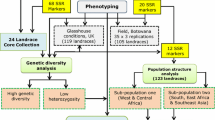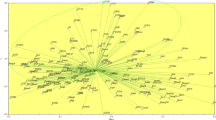Abstract
RAPD markers provide a powerful tool for the investigation of genetic variation in natural and domesticated populations. Recent studies of strain/cultivar identification have shown extensive RAPD divergence among, but little variation within, inbred species or cultivars. In contrast, little is known about the pattern and extent of RAPD variation in heterogeneous, outcrossing species. We describe the population genetic variation of RAPD markers in natural, diploid sources of dioecious buffalograss [Buchloë dactyloides (Nutt.) Engelm.]. Buffalograss is native to the semi-arid regions of the Great Plains of North America, where it is important for rangeland forage, soil conservation, and as turfgrass. Most sources of buffalograss germplasm are polyploid; diploid populations are previously known only from semi-arid Central Mexico. This is the first report of diploids from humid Gulf Coastal Texas. These two diploid sources represent divergent adaptive ecotypes. Seven 10-mer primers produced 98 polymorphic banding sites. Based on the presence/ absence of bands, a genetic distance matrix was calculated. The new Analysis of Molecular Variance (AMOVA) technique was used to apportion the variation among individuals within populations, among populations within adaptive regions, and among regions. There was considerable variation within each of the four populations, and every individual was genetically distinct. Even so, genetic divergence was found among local populations. Within-population variation was larger and among-population variation smaller in Mexico than in Texas. The largest observed genetic differences were those between the two regional ecotypes. These patterns of genetic variation were very different from those reported for inbred species and provide important baseline data for cultivar identification and continuing studies of the evolution of polyploid races in this species.
Similar content being viewed by others
References
Arnold ML, Buckner CM, Robinson JJ (1991) Pollen-mediated introgression and hybrid speciation in Louisiana irises. Proc Natl Acad Sci USA 88:1398–1402
Caetano-Anolles G, Bassam BJ, Gresshoff PM (1991a) DNA amplification fingerprinting using very short arbitrary oligonucleotide primers. Biotechnology 9:553–556
Caetano-Anolles G, Bassam BJ, Gresshoff PM (1991b) DNA amplification fingerprinting: a strategy for genome analysis. Plant Mol Biol Rep 9:294–307
Carlson JE, Tulsieram LK, Glaubitz JC, Luk VWK, Kauffeldt C, Rutledge R (1991) Segregation of random amplified DNA markers in F1 progeny of conifers. Theor Appl Genet 83:194–200
Excoffier L, Smouse PE, Quattro JM (1992) Analysis of molecular variance inferred from metric distances among DNA haplotypes: application to human mitocondrial DNA restriction sites. Genetics 131:479–491
Hadrys H, Balick M, Schierwater B (1992) Application of random amplified polymorphic DNA (RAPD) in molecular ecology. Mol Ecol 1:55–63
Hu J, Quiros CF (1991) Identification of broccoli and cauliflower cultivars with RAPD markers. Plant Cell Rep 10:505–511
Huff DR (1991) Sex ratios and inheritance of anther and stigma color in diploid buffalograss. Crop Sci 31:328–332
Huff DR, Wu L (1992) Distribution and inheritance of inconstant sex forms in natural populations of dioecious buffalograss (Buchloë dactyloides). Am J Bot 79:207–215
Kazan K, Manners JM, Cameron DF (1992) Genetic variation in agronomically important species of Stylosanthes determined using random amplified polymorphic DNA markers. Theor Appl Genet 85:882–888
Klein-Lankhorst RM, Vermunt A, Weide R, Liharska T, Zabel P (1991) Isolation of molecular markers for tomato (L. esculentum) using random amplified polymorphic DNA (RAPD). Theor Appl Genet 83:108–114
Michelmore RW, Paran I, Kesseli RV (1991) Identification of markers linked to disease-resistance genes by bulked segregant analysis: a rapid method to detect markers in specific genomic regions by using segregating populations. Proc Natl Acad Sci USA 88:9828–9832
Nei M, Li W-H (1979) Mathematical model for studying genetic variation in terms of restriction endonucleases. Proc Natl Acad Sci USA 76:5269–5273
Reeder JR (1971) Notes on Mexican grasses. IX. Miscellaneous chromosome numbers. Brittonia 23:105–117
Welsh J, McClelland M (1990) Fingerprinting genomes using PCR with arbitary primers. Nucleic Acids Res 18:7213–7218
Welsh J, Honeycutt RJ, McClelland M, Sobral BWS (1991) Parentage determination in maize hybrids using the arbitrarily primed polymerase chain reaction (AP-PCR). Theor Appl Genet 82:473–476
Wilde J, Waugh R, Powell W (1992) Genetic fingerprinting of Theobroma clones using randomly amplified polymorphic DNA markers. Theor Appl Genet 83:871–877
Williams JGK, Kubelik AR, Livak KJ, Rafalski JA, Tingey SV (1990) DNA polymorphism amplified by arbitary primers are useful as genetic markers. Nucleic Acids Res 18:6531–6535
Author information
Authors and Affiliations
Additional information
Communicated by A. L. Kahler
Rights and permissions
About this article
Cite this article
Huff, D.R., Peakall, R. & Smouse, P.E. RAPD variation within and among natural populations of outcrossing buffalograss [Buchloë dactyloides (Nutt.) Engelm.]. Theoret. Appl. Genetics 86, 927–934 (1993). https://doi.org/10.1007/BF00211043
Received:
Accepted:
Issue Date:
DOI: https://doi.org/10.1007/BF00211043




